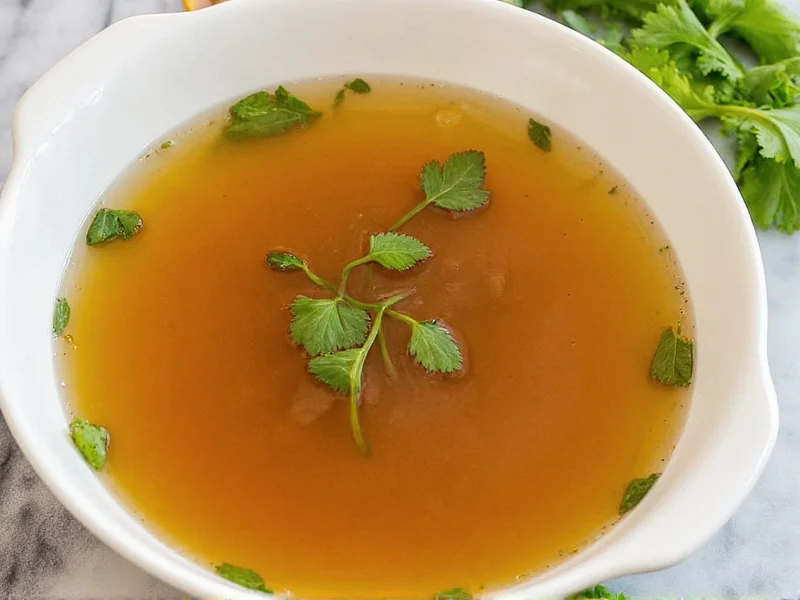Understanding the distinction between vegetable broth and vegetable stock is essential for home cooks aiming to elevate their culinary creations. While these terms often appear interchangeable on store shelves and in recipes, professional chefs and serious home cooks recognize important differences that impact flavor development and recipe outcomes.
Core Differences in Preparation and Purpose
The fundamental difference between vegetable broth and vegetable stock stems from their intended culinary purpose. Vegetable broth functions as a finished product—seasoned with salt and often herbs, it's designed to be consumed directly as a light soup or sipping beverage. In contrast, vegetable stock serves as an unseasoned cooking liquid, created specifically to enhance other dishes without dominating their flavor profile.
When preparing vegetable stock from scratch, chefs typically simmer vegetable scraps (like onion skins, celery ends, and carrot peels) for 45-60 minutes to extract maximum flavor compounds without adding salt. The resulting liquid remains neutral, allowing precise seasoning control in final dishes. Vegetable broth recipes, however, include salt and aromatic seasonings during cooking, creating a more immediately palatable product.
| Characteristic | Vegetable Broth | Vegetable Stock |
|---|---|---|
| Seasoning | Contains salt and herbs | Unseasoned (no salt) |
| Flavor Profile | Ready-to-eat flavor | Neutral base |
| Primary Use | Consumed directly or in finished dishes | Cooking foundation for sauces, soups, grains |
| Simmering Time | 30-45 minutes | 45-60 minutes |
| Ingredient Focus | Quality produce for direct consumption | Vegetable scraps and trimmings |
| Shelf Life | Shorter (due to salt content) | Longer (when properly stored) |
Practical Applications in Cooking
Knowing when to use vegetable broth versus vegetable stock significantly impacts your cooking results. For dishes where the liquid becomes part of the final presentation—like clear soups, risottos, or poaching liquids—vegetable stock's neutral profile allows you to control seasoning precisely. The absence of salt in stock prevents over-seasoning as liquids reduce during cooking.
Chefs preparing vegetable-based sauces or braises almost exclusively use vegetable stock because its concentrated, unseasoned nature integrates seamlessly with other ingredients. When making a simple vegetable soup to serve immediately, however, vegetable broth provides convenient, ready-seasoned liquid that requires minimal adjustment.
Substitution Guidelines
Many home cooks wonder whether they can substitute vegetable broth for stock and vice versa. The answer depends on your specific recipe and timing:
- Using broth instead of stock: Dilute with water (50/50 ratio) and reduce added salt in your recipe
- Using stock instead of broth: Add salt gradually while tasting, typically 1/4 teaspoon per cup
- For grain cooking: Stock provides better flavor control for dishes like quinoa or rice
- For finishing soups: Broth offers immediate seasoning without additional steps
Understanding these vegetable cooking liquid differences helps prevent common mistakes like oversalting reductions or creating bland final dishes. Professional kitchens maintain both options depending on the stage of recipe development.
Homemade Preparation Tips
Creating your own vegetable broth or stock from kitchen scraps offers superior flavor and reduces food waste. For vegetable stock, save clean vegetable trimmings (onion skins, celery leaves, carrot ends) in a freezer bag until you have 4-5 cups. Simmer with water for 45-60 minutes, then strain. For broth, use fresh vegetable pieces with herbs like thyme and bay leaves, simmering for 30-45 minutes with 1 teaspoon salt per quart.
Proper storage extends usability—freeze stock in ice cube trays for recipe-specific portions, while broth keeps refrigerated for 4-5 days. This approach to making vegetable stock from scratch ensures you always have the right cooking liquid available while minimizing waste.
Can I use vegetable broth instead of stock in recipes?
Yes, but with adjustments. When substituting vegetable broth for stock, dilute it with equal parts water and reduce added salt in your recipe. The pre-seasoned nature of broth can lead to oversalting as liquids reduce during cooking, particularly in sauces and reductions where stock's neutral profile works best.
Why do recipes specify stock instead of broth?
Recipes call for vegetable stock when precise seasoning control is crucial. Stock's unseasoned nature allows chefs to build flavors gradually without risking oversalting, especially important in reductions, sauces, and dishes where the cooking liquid concentrates during preparation. Using broth instead could result in an overly salty final product.
Does vegetable stock have nutritional advantages over broth?
Nutritionally, both contain similar vegetable-derived vitamins and minerals. The primary difference is sodium content—broth typically contains added salt (200-800mg per cup), while stock has minimal sodium. For sodium-restricted diets, unsalted stock offers better control, though both provide hydration and vegetable nutrients when consumed as part of balanced meals.
How long does homemade vegetable stock last?
Properly cooled and stored in airtight containers, homemade vegetable stock keeps for 5-7 days in the refrigerator. For longer storage, freeze in portion-sized containers—ice cube trays work well for recipe-specific amounts. Frozen stock maintains quality for 4-6 months. Always cool stock completely before refrigerating or freezing to preserve flavor and prevent bacterial growth.
What vegetables work best for making stock?
The best vegetables for stock include onion skins (for color), celery ends, carrot peels, leek tops, and mushroom stems. Avoid strong-flavored vegetables like broccoli or Brussels sprouts that can create bitter notes. For clear stocks, use lighter-colored vegetables. Save clean trimmings in the freezer until you have 4-5 cups, then simmer with water for 45-60 minutes for optimal flavor extraction without cloudiness.











 浙公网安备
33010002000092号
浙公网安备
33010002000092号 浙B2-20120091-4
浙B2-20120091-4